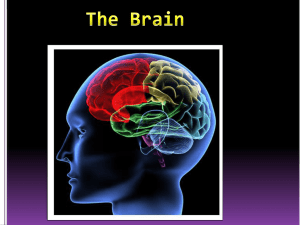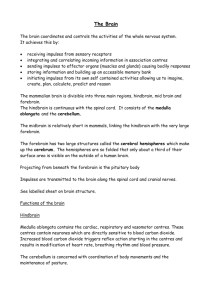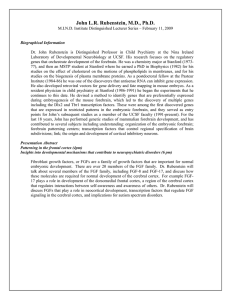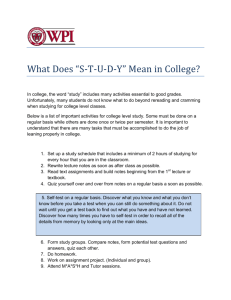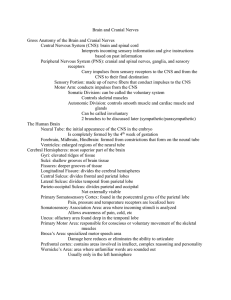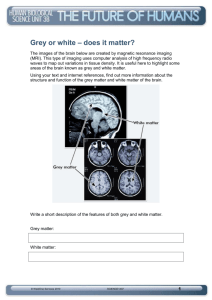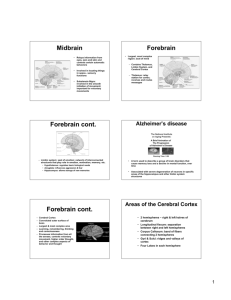What is biopsychology? Why study biopsychology?
advertisement
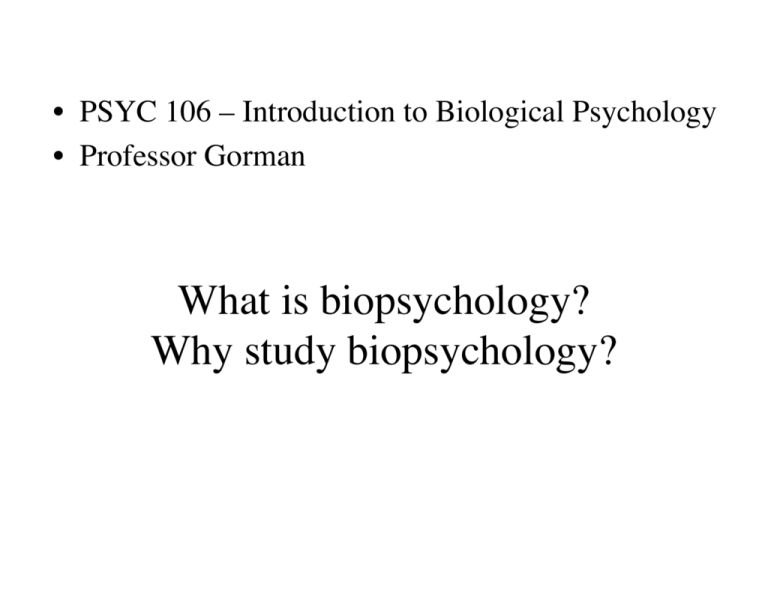
• PSYC 106 – Introduction to Biological Psychology • Professor Gorman What is biopsychology? Why study biopsychology? When you hear the word “biological,” what comes to mind? MANTRAS • Biology is NOT determinism • Brains produce behavior AND behavior changes brains • Multiple approaches COMPLETE, don’t COMPETE Anatomy – Physiology – Development – Evolution – Ecology – BOOK: Physiological, Ontogenetic, Evolutionary, Functional Why do birds sing? Why does your dog growl? Why is someone dependent on alcohol? Anatomy – The Neural Basis of Birdsong Fernando Nottebohm PLoS Biology 2005 Physiology – hormones from gonads alter firing rates of song structures Journal of Chemical Neuroanatomy 2010, 39:82–95 Gregory F. Ball Jacques Balthazart Development – Sensitive/critical periods Proceedings of the National Academy of Sciences Patricia K. Kuhl 100:9645–9646, 1999 Evolution – Phylogenetic tree of songbirds David F. Clayton, Christopher N. Balakrishnan, Sarah E. London; Current Biology; 2009; 19:R865–R873 Ecology– Thistle blooms may increase testosterone http://www.wired.com/wiredscience/2011/01/finch-thistle-testosterone/ Levels of Analysis: Reductionism vs emergent properties How does bird learn song? Through social interactions Through hearing/brain Through particular song nuclei Looking at structure of these nuclei Cellular mechanisms Ionic mechanisms An attempt to diagram an integration Current Opinion in NeurobiologyAvailable online 25 October 2012 Neurogenetics of birdsong Constance Scharff, Iris Adam • Monisha Sullivan • Nadine Burke • Anda & Felitti (ACE) • Michael Meaney • Bruce McEwen • Is it surprising that childhood traumas are associated with higher rates of addiction? • Heart disease? • Cancer? Abstracts on pubmed ACE sleep disease 3rd hit Not responsible for content Words of caution about studies … • • • • Replication and understanding are key Many tantalizing headlines Knowledge grows incrementally More ways to be wrong than to be right “Mechanisms” – HOW adverse experiences alter brain/body/mind? • Animal studies – fear/anxiety/hormones/ immune function/gene expression • Human studies try to confirm • PSYC 106 – Introduction to Biological Psychology • Professor Gorman Website http://gormanlab.ucsd.edu/ courses/psyc106.html Course Description: This course surveys the field of Physiological/Biological Psychology, an area of study concerned with physiological and evolutionary explanations of perception, cognition, and behavior. Because these functions depend on the nervous system, a major focus of the course will be on the structure and function of the brain with an emphasis on brainbehavior relations. Topics will include: evolutionary perspectives on brain and behavior, anatomy and development of the brain, neural signaling (neurotransmitters, drugs, hormones), and neural mechanisms of sensory processing, motor control (movement, action), motivated behavior (feeding, drinking), emotion, and learning and memory. Required Texts: Biological Psychology (11th Ed.) James W. Kalat, available at the bookstore Supplemental readings may be posted on the course website Optional Resources: Study Guide for Kalat's Biological Psychology Course Structure: Fundamentals Inputs -- Sensory Components Outputs -- Motor/Movements In-between -- Motivation/Cognition etc Odds and Ends Study Questions • Along what dimensions can the nervous system be usefully divided into smaller units, either functionally (i.e., in terms of how things work) or structurally (i.e., in terms of how it is built)? • Why and how does Nadine Burke use assessments of adverse childhood experiences (ACEs) in her San Francisco medical clinic? • Today 1.1, 4.1-4.3; New Yorker Article • Next Class 1.2; 2.1-2.2 Fig. 2-1, p. 28 Fly, worm, bacterium? Gray and white matter Gray = cell bodies White = axons/tracts Cerebro-spinal fluid (CSF) Cushions brain Drainage system Some flow of chemicals Disorders of cerebral ventricles http://physioforcare.com/blog/?page_id=180 Blood supply Upside: protects brain Downside: makes difficult to get treatment drugs to brain BRAIN à FOREBRAIN à CEREBRAL HEMISPHERES àCORTEX Motor cortex Working memory Attention Broca’s area Auditory processing Face recognition Wernicke’s area Sensory map Mental rotation Object ID by touch Hemi-neglect Visual processing Finer ways to demarcate cortical regions Not required to memorize these labels Brodmann’s areas based on structure of cortical layers 1-4 mm #4 inputs #3 outputs Choi, BIOL PSYCHIATRY 2009;65:227–234 BRAIN à FORE- MID- and HIND-BRAIN àSUB-CORTICAL AREAS Whole Brain Atlas http://www.med.harvard.edu/aanlib/home.html Not required, but very interesting Self-test question • The image shown below is from which type of section? • A. Sagittal • B. Horizontal • C. Coronal • D. Parallel • E. I don’t know Self-test question • • • • • • The big black arrow is pointing A. dorsally B. ventrally C. medially D. laterally E. caudally BRAIN à FOREBRAIN à CEREBRAL HEMISPHERES à BASAL GANGLIA Poorly named – next lecture Involved in motor control Parkinson’s disease Brain stimulators Tail-like nucleus (caudate) BRAIN à FOREBRAIN à CEREBRAL HEMISPHERES à LIMBIC NUCLEI Mammillary body memory/alcoholism Amygdala emotion/fear Hippocampus spatial learning Septum aggression BRAIN à FOREBRAIN à THALAMUS and HYPOTHALAMUS Thalamus relay sensory information to cortex Hypothalamus feeding sex controls pituitary fighting body temperature etc Self-test question Which number is placed near the corpus callosum? A. B. C. D. E. 1 2 3 4 5 2 3 4 5 1 Self-test question Which number is placed near the cortex? A. B. C. D. E. 1 2 3 4 5 2 3 4 5 1 Self-test question Which number is placed near the basal ganglia? A. B. C. D. E. 1 2 3 4 5 2 3 4 5 1 melatonin Sensory processing Spatial orientation Sleep Arousal Vital functions Sensory processing Arousal Bell-Magendie Law Just what a real spinal cord looks like Just 2 neurotransmitter chemicals two lectures from now Control multiple organs Coordinate “Take Action” dilate pupil increase heart rate inhibit digestion release glucose Ganglia along thoracic and lumbar spinal cord Arises above and below symp Has opposite effects Just one neurotransmitter No new information, just shows the PNS and SNS next to each other Summary • • • • Structured -- Not homogeneous mush Named descriptively Function is localized but also distributed Can identify structure/function (brain/ behavior) relationships
